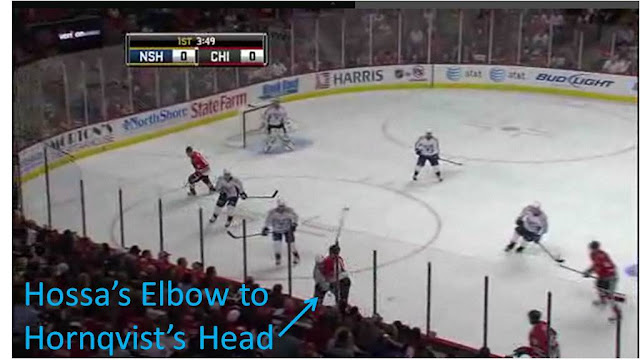Chicago is a blazing fast team. We've heard so much in this series that the Preds need to clog the neutral zone in order to be effective. What happens when the Preds
don't clog the neutral zone? You blink and CHI goes from defense to having two great shots that would have been goals, if not for the heroics of Pekka Rinne.
The Video
The Breakdown
Before I start, let me point out that I am using a highlight of the penalty kill to emphasize the important of clogging up the neutral zone during regular strength play. I chose the PK example for two reasons: (1) because it shows the importance of staying out of the box, and (2) it is just a great example of what happens when we do not clog up the zone. Besides, the Preds do such a good job of clogging the zone, it was hard to find a good, even strength example of when we don't.
1.
0:05 seconds to disaster. The play starts harmlessly. The Chicago defense has the puck, executing an otherwise bland, average, breakout. Versteeg and Hossa are slightly ahead of the play, ready to receive a pass. Kopecky is to the left of the shot, ready for a long bomb pass.
2.
0:04 seconds to disaster. Hossa receives the pass. No Predators are even close to defending him. He is full speed now, and there is nothing to slow him down.
I'm starting to really hate this guy.
3.
0:04 seconds to disaster. The red dotted line represents the distance Hossa has traveled since the last frame (that is to say within the same second,
are you f'ing serious!?). The blue dotted line represents C Marcel Goc.
4. RW Smithson tries to use his stick to break up the pass of Hossa. Unfortunately, he is not quick enough to get his stick into the passing lane. As a result, Hossa will both get the pass off and continue full speed into the zone.
The Predators do not have enough pressure on the Chicago players in the neutral zone. The Blackhawks are able to enter and travel in the neutral zone too easily. If the Preds had one more skater in the neutral zone, it would go a long way in breaking up those passes. The Predators must do this (i.e. "Clog the Zone" or "Execute the Trap") in order to neutralize Chicago's speed.
5.
0:02 seconds to disaster. Hossa continues to fly unabated into the zone, and is still leaving Goc in the dust. LW Versteeg
(ok, he's listed as a RW, but he's playing on the left. I don't know what the actual line ups were, and honestly, I don't care. I hate these guys) has the puck, and as soon as he enters the zone, C Kopecky, #82 enters as well.
6. As the three CHI forwards enter the zone, they create a three-on-two situation. The defenders are on their heals. The defense covers the LW and RW, leaving C Kopecky unguarded.
7.
0:01 seconds to disaster. Versteeg makes a perfect pass to Hossa, of course, who immediately turns the pass into a shot on net. Preds' D Klein actually has good positioning on Hossa, but regardless, Hossa gets the shot off.
Oh, and #82 C Kopecky... he's going to skate full speed toward the front of the net, with no one to stop him... so there's that. Smithson and Goc look slow backchecking, in comparison.
8.
0:00 seconds to disaster. C Kopecky is unguarded and takes a full on slap shot at point blank range. If Pekka Rinne doesn't "make the save" so much as he is able to get into position and simply absorb the blast. Thank god those goalie pads are pretty thick.
Wrap Up
Yes, this was a penalty kill. This tic-tac-toe passing play may not happen during even strength... if we execute the trap right. However, Chicago has proven over the course of the season that they can play this run-and-gun game on the power play, at even strength, or even short handed. In my opinion, if the Preds are going to win more games, its going to have to follow the blueprint of game one pretty closely. For the next few games, slow and boring is beautiful.




























